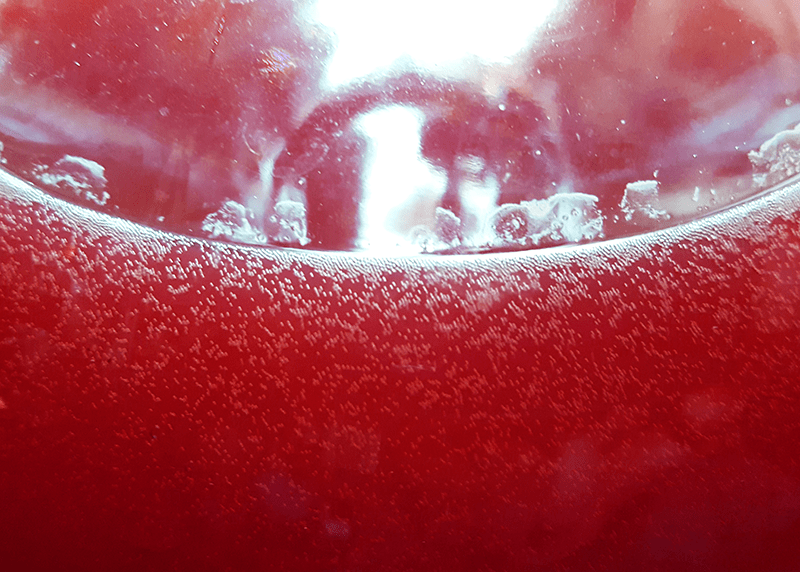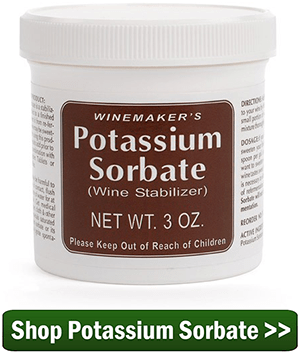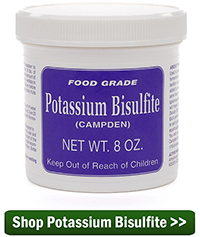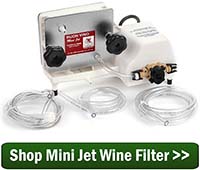 As the yeast eats the sugars, the sweet taste disappears as the sugar is eaten. I have heard you can’t stop the yeast from doing their job. But if I want a sweeter wine and my reading has reached an SG of 1.010, can I put potassium sorbate in the fermentation to stop it there for some sweetness instead of letting it ferment to the end at .998 and having to try and back sweeten a dry wine?
As the yeast eats the sugars, the sweet taste disappears as the sugar is eaten. I have heard you can’t stop the yeast from doing their job. But if I want a sweeter wine and my reading has reached an SG of 1.010, can I put potassium sorbate in the fermentation to stop it there for some sweetness instead of letting it ferment to the end at .998 and having to try and back sweeten a dry wine?
Byron J. — FL
—–
Hello Byron,
This is a great question because it covers a two wine making topics that often trip up home winemakers: using potassium sorbate and sweetening a wine.
Let me start off by saying that it is possible to stop a fermentation in progress, but it is much more difficult than just using potassium sorbate to stop a fermentation and/or sulfites such as Campden tablets and sodium metabisulfite. These wine making ingredients will give the fermentation a blow to the gut, but vary rarely will they permanently stop a fermentation. Not good enough for a homemade wine that is destined to be bottled. The last thing any winemaker wants is fermenting bottles of wine.
The potassium sorbate does not stop or inhibit the fermenting in any way. What it does do is stop the yeast from reproducing themselves. During a typical fermentation the wine yeast will go through several re-generations. By adding potassium sorbate to a wine you are making sure that the current generation of yeast is the last generation of yeast. Eventually, the wine yeast will begin to die, but not all at once. Some yeast will live longer than others always leaving a possibility of a re-fermentation occurring, even months down the road.
 Sulfites, like the Campden tablets and sodium metabisulfite, will destroy some of the yeast cells but not all of them. Domesticated wine yeast are somewhat immune to the effects of sulfite. They are acclimated to the sulfites when they are being produced. This is done on purpose so that a fermentation can exist with some of the protective benefits of sulfites.
Sulfites, like the Campden tablets and sodium metabisulfite, will destroy some of the yeast cells but not all of them. Domesticated wine yeast are somewhat immune to the effects of sulfite. They are acclimated to the sulfites when they are being produced. This is done on purpose so that a fermentation can exist with some of the protective benefits of sulfites.
Since potassium sorbate won’t stop a fermentation, here is what a commercial winery does when they want to stop an active fermentation:
- Chill the fermentation tanks down to about 45°F. This causes the wine yeast to stop their activity and drop to the bottom. This can be done in a matter of 3 or 4 days depending on how fast the tanks chill. As a home winemaker, refrigeration should be done for at least a week.
- Rack the wine off the sediment. The sediment is mostly yeast cells at this stage of the winemaking process, so by racking or siphoning the wine, you are leaving most of the yeast behind.
- Filter the wine. It is vital that the wine be finely filtered at this point. While almost all of the wine yeast is gone, if some is left in the wine they can propagate themselves into larger numbers, regenerating a new colony of yeast that can ferment the wine after it has been bottled. Not a good thing. A winery will typically filter a wine down to .5 micron. This will require filtration under pressure with an actual wine filter system.
 This is how a winery controls the sweetness of a wine, but there is a much, much easier way available to the home winemaker. It doesn’t involve using potassium sorbate to stop a fermentation, and it doesn’t involve going through all the steps laid out above.
This is how a winery controls the sweetness of a wine, but there is a much, much easier way available to the home winemaker. It doesn’t involve using potassium sorbate to stop a fermentation, and it doesn’t involve going through all the steps laid out above.
- Allow the fermentation to finish. All the sugars will be gone and the wine yeast will start dropping out.
- Rack the wine off the sediment. Again, this will leave most of the yeast behind – well over 90%.
- Add sugar syrup to taste. The sugar syrup can be made by taking equal parts water and sugar and heating them in a sauce pan until completely clear. You may want to take a measured portion of the wine and add measured portions of the sugar syrup to establish a dosage, first, before committing the entire batch.
- Add potassium sorbate and sulfite to the wine. The dosage should be listed on the containers they come in, but you want to use 1/2 teaspoon of potassium sorbate per gallon and 1/16 teaspoon per gallon of either: potassium metabisulfite, sodium metabisulfite, or 1 Campden tablet per gallon of wine.
- Bottle the wine right away. If the wine is allowed to sit, some of the sulfite will dissipate, so you will want to bottle the wine on the same day.
By allowing the wine to finish, you will have much greater control on the sweetness of the wine. Instead of saying I want the wine to finish at a specific gravity 1.010, as you have suggested, you can actually sweeten the wine to taste. This is important because some wines require more sugar than others to get the same effect of sweetness than others. Every wine is different.
By operating in this way you can also bulk age the wine first. This is a great advantage, because it allows you to sweeten the wine after the harshness has been aged out. Often times when sweetening a young, too much sugar will be added. This is because the winemaker tries to cover up the harshness with sweetness — a harshness that won’t be there later.
Byron, I hope this information helps you out. Again, I’m glad you asked about using potassium sorbate to stop a fermentation for the simple fact that it’s answer will help to clear up a lot of confusion among new winemakers.
Happy Winemaking,
Ed Kraus
—–
Ed Kraus is a 3rd generation home brewer/winemaker and has been an owner of E. C. Kraus since 1999. He has been helping individuals make better wine and beer for over 25 years.

Sulfites suppress bacteria much more than they do yeast; in fact the addition of sulfites at crush is more to suppress the bacteria than "wild" yeast. A modest sulfite addition at crush actually accelerates a native yeast fermentation. Therefor, trying to "kill" a yeast fermentation with sulfites is a really bad idea–it would take way too much.
Great article Ed. Thank you so much. You provided a lot of good insight and basic information on yeast cycles and reaction with sulfites and how temperature plays a role.
Ed, in item #5 you say to bottle the wine right away. Then below in the second paragraph you talk about bulk aging to get rid of the harshness . So if I understand what you are saying one would return the wine to a carboy for a period of time say 1-3 months and then sugar to taste.
There are 2 options. You can age the wine in the bottle -or- age the wine in the carboy. The harshness goes away after time either way.
1)If you can sweeten the wine with the harshness, you bottle right away.
2)If you need that harshness to go away first or want to be very exact about the sweetness, I would age it in the carboy before bottling.
3)My little twist to it all: You can make a bottle/jar of simple syrup and add it too your glass as you drink it if that helps you figure it all out. 🙂
I use resistant yeast to get higher alcohol, and run my wine to the end of fermentation by adding small amounts of sugar to raise hygrometer. When done I re-sweeten small amount at a time to see if re-ferment happens. when quiet add sugar, I dissolve it with a little wine I draw off each time,when sweet let it set a week before bottling to make sure yeast is dead–works every time.
Sorry I have no comment, but a question: My wine stopped fermenting,
how can I get it to ferment again to use up all the sugar?
Best regards,
Heinz
Heinz, before you can know what to do you need to figure out why the fermentation stopped. There are a number of reasons this can happen. The quickest way to get to the bottom of things is to go over the following article:
Top 10 Reasons For Fermentation Failure
http://www.eckraus.com/wine-making-failure/
These 10 reasons cover over 95% of the issues we’ve seen. See which one of them rings true for your situation.
Thank you Ed. I am able to produce quality wine for personal use and I learned most of it from you. Thanx again
in what order to I: fine the wine; add preservatives; back sweeten?
Ray, you want the wine clear and ready to bottle, then you can add the potassium sorbate and sweetener. The sulfites are added at the time of bottling.
Ron, whether you age in bulk or in the wine bottle is of personal preference. I personally thing bulk aging does better, but that is not the reason for stating #5. I was simply pointing out that when you add sulfites, you need bottle it or bulk age it before before the sulfites have a chance to dissipate. You want to trap the sulfites in the bottle whether it be wine bottle or carboy.
Hi! I just made my first 5 gallon batch of white zinfandel from fruit. I kept about a half gallon of the pressed juice in the freezer to use as a back sweetner. what is the process for using the grape juice as a sweetner? do I add the potassium sorbate to the juice itself and then add it to the wine? sorry this is responding to an old post.
John, you want to add the potassium sorbate to the wine and then add the juice.
Do not add potassium sorbate to your grape wine – ever. Any commercial winemaker will tell you that potassium sorbate breaks down over time into ethyl sorbate which takes on disgusting chemical flavors such as old celery.
Hello, my name is Rocky.
I’m doing a 3 gal batch of South African Pineapple-Raisin Beer. I found out that it is not actually a Beer, but a Fruit Wine. I actually used Ale Yeast to Ferment.
I took a SG reading of 1.070 and got another quick reading on day 10 of 1.008.
It’s still bubbling in the airlock!
My question is: How long does the Fermentation last for this type of Wine?
And what should be my FG reading be?
I’m new to this hobby and want this to come.out great!
Thanks for any info you can give!
Cheers!
Rocky, fermentation can take as little as a week or as long as 4-6 weeks depending on the conditions. The fermentation is complete once the specific gravity reaches .998 or less.
Is it possible to add a sweetner that doesn’t start the fermentation process, like xylitol for example, in order to avoid having to use potassium sorbate and sulfite?
Peter, unfortunately, since we do not know how artificial sweeteners will break down over time, we always recommend using potassium sorbate no matter what you choose to sweeten your wine with.
Hello am yves from Rwanda I really want to know all about fermentation cz next year after my bachelor graduation i have I deal of making wine so hope this site will help me so I have 2 questions one is how to avoid haize in banana wine second is it possible to get sweet wine without adding sugar after fermentation? Thx! !!!
Kabagamba, Because bananas are rich in pectin, your wine may have developed a pectin haze. Below is an article link on how to clear a wine with a pectin haze. When a wine fermentation completes, all of the sugar has been converted into CO2 and alcohol leaving a dry wine. If you try to stop a fermentation before it completes, there is a possibility that it could start to ferment in the bottles and that could cause a big mess if the corks pop out. We recommend letting the fermentation complete and back sweetening the wine at bottling time after stabilizing with potassium sorbate.
Pectin Haze
https://blog.eckraus.com/clear-pectin-haze-pectic-enzyme
Happy Holidays to you and yours, Ed.
I am curious:
1. does it matter if I add the pot. sorbate before or after my simple syrup? stabilization for the sorbate takes ~24 hours, right?
2. when I add the pot sorbate, and campden tablet, there is some visible material the next. Do I need to make sure I stir these materials in next time so that it is evenly distributed before I rack it all into bottles?
3. in your guide, it seems that it is OK to add both the sorbate and metabisulfate/campden tablet at the same time, but I am inferring differently from the comments section on the order of things. Thank you for the clarification.
Cheers,
It really does not matter what order you put the sugar and potassium sorbate in the wine. It is only important that you add the potassium soon enough that the wine doesn’t have enough time to start fermenting the newly added sugars.
Next time, you might try taking a half gallon of the wine, or so, and dissolve the potassium sorbate and Campden tablets in that first. Then add it to the rest of the wine.
Both the potassium sorbate and Campden tablets can be added at the same time. The is no adverse reaction between the two that will happen.
HI Ed.. The goal of the liquid is to stop the fermentation and not produce any ETOH. WE are holding the juice at 44 now till we decide on the path. Juice is 23 bx. Added some potassium metabisulfide. to shock the yeast a bit until we decide a path. The food grade bulk polysorbate was recommended by a industry friend. WE have the ability to filter. Holding the juice to settle is a problem however.